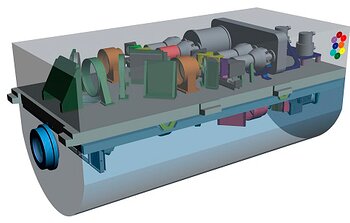Octocam Looks Toward a New Era of Discovery
April 4, 2017

Gemini Observatory announces the development of a major new facility-class broadband optical and near-infrared imager and spectrograph named OCTOCAM.
"OCTOCAM provides Gemini with a unique capability as we look ahead to the Large Synoptic Survey Telescope era," says Stephen Goodsell who manages the instrument program for Gemini. "The instrument will be able to rapidly acquire transient objects and simultaneously obtain eight images or spectral bands from each target," according to Goodsell. "This is important because it provides a much greater level of information and detail, which will undoubtedly lead to transformational scientific discoveries."
The power of the instrument comes from its ability to simultaneously observe over an extremely wide swath of the optical and infrared spectrum. It is expected that when the instrument begins commissioning and observations in 2022 it will serve as an ideal complement to the discoveries made with the Large Synoptic Survey Telescope (LSST) by providing rapid follow-up capabilities.
Once completed the instrument is slated for installation on the 8-meter Gemini South telescope which is located adjacent to the current construction site of the LSST on Cerro Pachón in Chile.
"Two core tenets of Gemini's future vision are to lead as a premier facility for taking advantage of the upcoming discoveries from the LSST; while offering broad, flexible capabilities that enable a wide-range of individual PI-driven science," says Scot Kleinman, Associate Director of Development at Gemini. "OCTOCAM, with its eight simultaneous channels, including both imaging and spectroscopic capabilities, moves Gemini a giant step closer to this vision. We are thrilled to make this transformative instrument available to our community in early 2022."
Chris Davis, Program Officer at the U.S. National Science Foundation (NSF, which also funds the LSST), notes that because Gemini has international funding participants that include the U.S., Canada, Brazil, Argentina, and Chile, this project spans the globe. "All of the Gemini participants contribute to the development of instruments like OCTOCAM," says Davis. However, he adds, "OCTOCAM really captures the spirit of international cooperation with the global network of researchers that are designing and building this instrument."
In late March the Association of Universities for Research in Astronomy (AURA, which operates Gemini on behalf of the NSF) and the Southwest Research Institute (SwRI) signed a contract to build and commission the instrument. With the contract signed work began immediately on the conceptual design of the instrument. Please see SwRI press release here.
“Using eight state-of-the-art detectors, OCTOCAM will simultaneously observe visible and invisible light spectra almost instantaneously, in tens of milliseconds,” said Dr. Peter Roming, a staff scientist at SwRI who will serve as project manager and co-principal investigator. SwRI will oversee systems engineering, providing detectors, electronics, and software development for this refrigerator-sized, ground-based apparatus. The Institute will also lead the integration and testing of the device.
“It’s really exciting to be working on an 8-meter class instrument that will be used to observe the whole Universe, from the oldest stars to nearby exoplanets,” Roming said. “The imaging, spectral analysis, and temporal resolution combined with exceptional sensitivity make OCTOCAM a unique, unparalleled instrument.”
"OCTOCAM has been designed to revolutionize the research in many fields of astrophysics. To achieve this, a large, international group of scientists determined the key science questions to be addressed in the coming decade and those were used subsequently to define the technical characteristics that will allow OCTOCAM to answer them," says Antonio de Ugarte Postigo, scientist at the Instituto de Astrofísica of Andalucía (IAA-CSIC) in Granada, Spain and principal investigator of the project.
"We look forward to a work that will involve the full scientific community of Gemini. OCTOCAM will open a new window of research by occupying a region in the spectral coverage-spectral resolution-time resolution diagram not covered by any other instrument in the world," says Christina Thöne, scientist at IAA, Granada and Deputy Project Manager of OCTOCAM.
"I am very excited about the science that we will be able to do with OCTOCAM," said Dr. Alexander van der Horst, an assistant professor of astrophysics at the George Washington University in Washington, DC, and the project scientist for OCTOCAM. "The capabilities of OCTOCAM make it a unique instrument, and it will provide a wealth of information on a very broad range of objects, from rocks of ice in our own solar system to the most massive stars exploding at the edge of our Universe."
More Information
Please visit OCTOCAM page for the list of team members and more.
Contacts
Stephen Goodsell
sgoodsell@gemini.edu
+44 7539256513
Gemini Program Manager Durham University
Durham
UK
Scot Kleinman
kleinman@gemini.edu
808 074-2618
Gemini Head of Development Gemini Observatory
Hilo
Hawai‘i
Peter Michaud
pmichaud@gemini.edu
808 974-2510
808 936-6643
Public Information and Outreach Manager Gemini Observatory
Hilo
Hawai‘i

